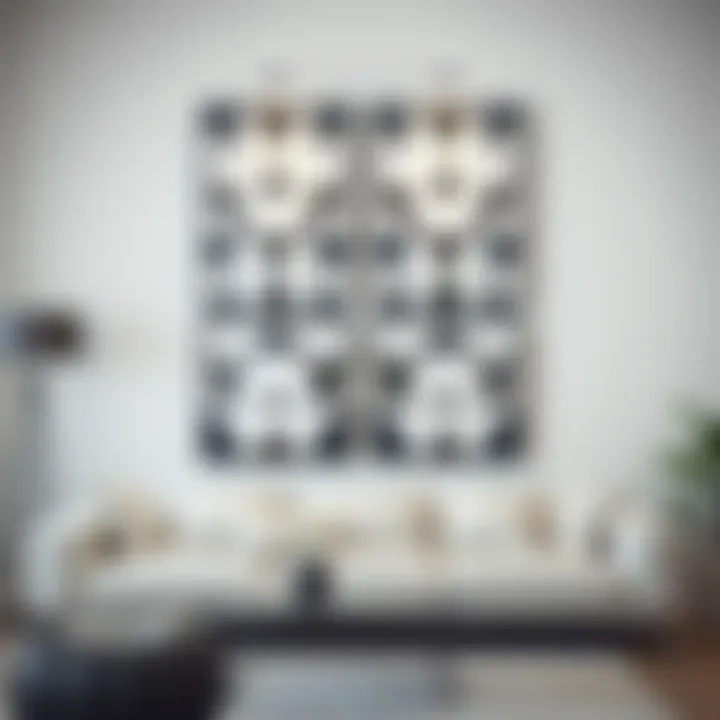Exploring Four Panel Art Sets in Interior Design


Intro
Four panel art sets have carved a niche in the realm of contemporary interior design. Their significance stretches beyond mere decoration; they can transform the entire vibe of a space. Each piece in these collections serves as a brushstroke in a larger artistic expression, blending styles, themes, and emotions. As such, understanding their aesthetic and functional appeal is crucial for homeowners and designers alike.
Given the ever-evolving nature of interior design, it's essential to keep our fingers on the pulse of trending materials and textures alongside the selection of color palettes and styles. These factors not only enhance the visual impact of four panel art sets but also dictate their synergy with existing decor.
To navigate this sea of options, let’s delve deeper into furniture design trends. By understanding these trends, one can make informed choices that elevate the aesthetics and functionality of their spaces.
Furniture Design Trends
When discussing modern interiors, one can't overlook current furniture design trends that complement four panel art sets beautifully. Not only do these trends shape our environments, but they dictate how art and furniture harmonize within a room.
Trending Materials and Textures
Modern art sets come with a variety of materials. The choice of material can influence the artwork's emotional resonance and how it relates to the surrounding furniture. For instance:
- Canvas remains a classic choice due to its versatility and ability to adapt to various styles, from rustic to modern minimalist.
- Metal and Wood frames add a touch of sophistication and warmth, offering both strength and style.
- Acrylic provides a contemporary twist, allowing for vibrant colors and durability that withstands the test of time.
Texture also plays a crucial role. The juxtaposition of smooth and rough elements in an art piece can create a dynamic interplay of interests. It is, therefore, vital to mix materials strategically to evoke harmony in your space.
Color Palettes and Styles
The color palette of a four panel art set sets the tone for the entire room. It’s like choosing the right spices in a dish; the right blend can elevate the entire experience. Consider the following:
- Monochromatic Schemes invite calm and easy sophistication. Shades of blue or gray can enhance a tranquil setting.
- Complementary Colors add vibrancy and energy—think about a fiery orange contrasted with deep blues for a room that sparks conversation.
- Earthy Tones offer grounding and warmth, perfect for bringing the outside in.
The art style itself can vary widely; abstract pieces might stimulate imagination, whereas landscapes evoke serenity. It’s wise to match the style of the art to the overall theme of the room.
"Art enables us to find ourselves and lose ourselves at the same time." – Thomas Merton
Practical Tips for Furniture Selection
Selecting the right furniture to accompany four panel art sets requires an eye for both aesthetics and practicality. It’s a dance between style and functionality that defines a successful space.
Assessing Space and Functionality
Before deciding on the furniture, assess the room's dimensions and purpose. Ask yourself:
- How often will the space be used?
- What activities will take place here?
- Can I merge comfort with style?
If it’s a high-traffic area, durable furniture might be warranted. In contrast, a low-usage space might allow for more delicate choices. Always measure your area to avoid overwhelming it with oversized pieces or leaving it sparse and without character.
Balancing Aesthetics with Comfort
There’s a fine line between style and comfort. While it's tempting to go for visually stunning pieces, never underestimate the value of comfort, especially in living rooms or bedrooms. Potential buyers should look for furniture that showcases:
- Ergonomic Designs that provide support and comfort without sacrificing style.
- Flexible Arrangements that allow the space to flow rather than block it.
When selecting furniture, consider how each piece interacts with the four panel art sets. Ideally, furniture should complement the artwork’s essence while being inviting and functional.
Foreword to Four Panel Art Sets
Four panel art sets have captured the imagination of artists and decorators alike. They offer a unique combination of aesthetic pleasure and functional design, which helps transform ordinary spaces into extraordinary environments. Each panel tells a part of a larger story, together forming a cohesive visual narrative that can breathe life into both homes and professional spaces. Through this article, we aim to explore different facets of four panel art, highlighting their significance in contemporary design.
The appeal of these panels lies not only in their visual impact but in how they can reflect personal style and enhance the functionality of a room. From adding depth and dimension to providing a focal point, these art pieces can effectively influence the mood of a space. Moreover, they can be a reflection of cultural stories or personal experiences, allowing homeowners and designers to infuse their spaces with meaningful imagery.
Definition and Overview
Four panel art sets typically comprise four separate, yet harmoniously related pieces of artwork that are intended to be displayed together. Unlike traditional singular pieces, these sets allow for greater creativity in arrangement, introducing a dynamic element to wall decor. They can be made from various materials, ranging from canvas to wood or acrylic, and can depict everything from abstract patterns to serene landscapes.
The versatility of four panel art sets makes them suitable for a range of environments, whether it be the warmth of a living room, the calm of a bedroom, or the energy of an office. For instance, an abstract set may inject a modern flair into a minimalist decor, while a landscape-themed arrangement can evoke tranquility and connection to nature.
Historical Context
The concept of partitioning art into multiple panels is not new. Historically, multi-panel paintings were prevalent during the Renaissance, where altarpieces formed from several panels depicted religious narratives. Each piece served a specific role, contributing to the overall story being told, much like today’s four panel sets.
As time progressed, artists began experimenting with multi-panel arrangements in various styles. The 20th century gave birth to modernism, which encouraged abstract interpretations and the breaking of conventional boundaries. As a result, four panel art sets began to gain traction, allowing artists and designers to push their creative limits and explore themes in a more segmented manner. The growth of print technology further democratized this form of art, making it accessible to a wider audience.
In recent years, the rise of minimalist and modern design trends has solidified the four panel art set as a staple in contemporary homes. Their ability to straddle the worlds of artistic expression and functional decor epitomizes the evolving relationship between art and interior design.
Art Styles in Four Panel Sets
The world of four panel art sets brims with a variety of artistic expressions. Each style encapsulates a unique narrative and emotional resonance, bridging the realms of aesthetic appeal and functional use in interior design. Selecting the right art style can elevate the visual language of a space, affecting the atmosphere and energy of a room. Hence, understanding these different styles is pivotal for homeowners and designers alike, as it allows for a more tailored integration into existing decor. This section delves into various art styles found in four panel sets, outlining their individual characteristics and the sentiments they evoke.


Abstract Art
Abstract art thrives on the beauty found in shapes and colors rather than direct representation, offering viewers a chance to interpret the pieces through their subjective lens. In the realm of four panel sets, abstract art functions particularly well as it allows for a dynamic arrangement that can play off different visual perceptions. Each panel can present a distinct element of a broader concept, be it rhythm, movement, or cohesion. Such sets can serve as a focal point in a minimalist room, drawing attention without overwhelming other design aspects.
Common keywords that resonate with abstract art include color balance and emotional depth. As an art style, abstract pieces often bring a modern sensibility that can seamlessly blend with both contemporary and traditional aesthetics. For those looking to infuse energy into their living spaces, offering an opportunity for varied interpretations, abstract four panel sets could just be the key.
Nature and Landscape
Nature-themed art is another prevalent style in four panel art sets, drawing upon the natural world to instill calmness and serenity into spaces. The appeal here lies not only in the beauty of landscapes but also in the emotions they evoke. A breathtaking mountain range, a tranquil lake, or a dense forest can transform a space into a sanctuary of peace. Choosing a four panel representation of natural scenes can create a sense of continuity and wholeness, as one scene flows into another, each panel adding layers to the overall composition.
Moreover, landscapes can serve to enhance spatial perception, making a room feel larger or more connected to the outdoors. This approach is especially beneficial in urban settings where such connections to nature are less apparent. With color palettes rooted in nature, these sets often incorporate greens, blues, earthy tones, and soft hues, blending harmoniously with various decor styles.
Modern and Minimalist
In today’s design landscape, modern and minimalist art styles resonate with the ethos of simplicity and functionality. Four panel sets curated under this approach embrace clean lines, geometric shapes, and a limited color palette, reinforcing a sleek and organized aesthetic. This style works well in spaces where clutter is to be minimized, fostering a sense of peace and balance.
Utilizing white space effectively, modern and minimalist art can offer a refreshing break from overly ornate decor, allowing a room to breathe. It’s important to note that this style embodies the notion of 'less is more'—each panel might feature an aspect that builds upon the central theme without extraneous detail that could detract from the overall impact. Homeowners seeking tranquility in their environments may find these sets particularly appealing.
Cultural and Ethnic Themes
Cultural and ethnic themes in four panel art sets offer a rich tapestry of stories, traditions, and historical nuances. They present an opportunity to celebrate heritage, art, and history, whether through indigenous patterns, folkloric motifs, or historical depictions. These artworks can be conversation starters — each piece may communicate deep-rooted narratives that resonate on personal and communal levels.
Incorporating such art into a decor scheme not only beautifies the space but also honors the diverse cultures and histories that shape our world. Additionally, this style can bridge modern design with traditional aesthetics, appealing to a broad audience. Designers may consider how these themes can complement other elements within a room, perhaps providing a cultural counterbalance to more contemporary artifacts.
By exploring these varied art styles in four panel sets, it becomes evident that art is not merely decorative; it leverages emotional and cultural connections, enhancing the functionality and ambiance of any space.
The Composition of Four Panel Art Sets
The composition of four panel art sets plays a crucial role in shaping not only the aesthetic appeal but also the functional aspects of a space. By carefully selecting how the pieces are arranged, homeowners and designers can manipulate the viewer's perception of space, create focal points, and establish a certain mood. This aspect of art presentation often gets overshadowed by the artwork itself, but the arrangement significantly influences how an artwork is experienced.
Layout Options
Linear Arrangement
The linear arrangement of four panel art sets is perhaps the simplest yet effective strategy. This layout forms a continuous visual flow that leads the viewer's eye across all panels. This arrangement emphasizes the narrative or theme of the artwork. It encourages the audience to take in the entire story as if flipping through the pages of a picture book.
A key characteristic of linear arrangements is their adaptability. They suit almost any type of artwork, from serene landscapes to dynamic abstract pieces. This versatility makes them a popular choice among designers aiming for a harmonious look, particularly in more traditional or classical spaces.
One unique feature of linear arrangements is their ability to elongate narrow spaces. By hanging the artwork horizontally, it can make a space feel wider, providing an illusion that enhances the perception of the room. However, one disadvantage might surface when trying to fill wider walls, as they might need to include other elements or artworks to avoid looking sparse.
Asymmetrical Configuration
Asymmetrical configuration introduces a dynamic element to four panel art sets. This layout breaks free from the conventional alignment, creating visual interest and complexity through varied spacing and differing sizes of panels. The unique harmony that emerges from asymmetry often draws the viewer's eye and stimulates emotional responses.
The key characteristic of this arrangement is its unpredictability. It can turn even the most mundane wall into an intriguing focal point. This configuration works particularly well in modern interior designs, where creativity and boldness are encouraged.
The benefit of an asymmetrical layout lies in its capacity to integrate smoothly with various décor styles. However, it does demand a thoughtful approach; if not executed properly, it can lead to a chaotic look, potentially overwhelming the viewer. Finding that sweet spot is vital here.
Grid Patterns
Grid patterns add a structured yet modern flair to four panel art sets. This layout involves arranging the four panels in a square or rectangular formation, balancing each piece to create uniformity and cohesion. This method is often hailed for its symmetry and organization, making it popular in minimalist designs.
A prominent characteristic of grid patterns is their clean look, often promoting a sense of calm and order. The uniformity tends to complement contemporary art styles, which focus on color and form rather than traditional representation.
Nonetheless, a potential drawback arises if the grid feels too rigid. It may not evoke as much emotional engagement, possibly leaving a space feeling sterile. Therefore, careful consideration of the artwork’s own personality and how it meshes with the arrangement is essential.
Color Harmony and Contrast
Color harmony and contrast play vital roles in how compositions are perceived. The interactions between hues can make or break the effectiveness of a four panel art set. The right blend can create a soothing atmosphere, while stark contrasts can inject energy into a space. Understanding the psychology of color is paramount for anyone trying to make the best out of their art set-up.
Framing and Matting Considerations
When it comes to framing and matting, these aspects contribute significantly to the overall effect of a four panel art set. The choice of frames can either complement or distract from the artwork itself. Clean, simple frames often work well with busy pieces, while more ornate frames can enhance simpler artworks. Utilizing matting strategically not only brings artworks together but also provides them with a cleaner boundary, elevating the visual impact.
Impact on Interior Space
Four panel art sets offer a unique approach to transforming interior spaces, creating an atmosphere that is both visually appealing and functionally advantageous. Their significance lies not only in aesthetics, but also in their ability to influence perception and mood within a room. With careful consideration of placement and style, these art sets can become essential components in the architectural storytelling of a space. Factors such as composition, thematic choice, and color palette play pivotal roles in how one can effectively utilize these pieces to enhance the overall interior.
Creating Visual Focal Points
A well-positioned four panel art set can serve as a striking central feature in any room. These sets are capable of drawing the eye immediately, creating a focal point that anchors the space. For instance, placing a vibrant abstract design over a neutral sofa can transform an ordinary living room into a lively gathering area. One cannot overlook the balance that such a display can establish—symmetry in arrangement can provide a sense of calm, while an asymmetrical arrangement may energize the room.
- Considerations for Placement:
- Height: Hanging art at eye level typically makes it more approachable.
- Surroundings: Ensure that the artwork complements the furnishings and colors used throughout the room.
- Lighting: The right illumination can enhance colors and textures, making the art pop even more.


Engaging art can draw attention to other elements of the room too, encouraging viewers to take in the entire space instead of simply the artwork. This creates a holistic experience, amplifying the visual storytelling and design intention.
Enhancing Spatial Perception
Four panel sets can cleverly manipulate the perception of space, particularly in smaller areas or those lacking depth. Strategic placements can give the illusion of larger dimensions or even create an airy, spacious feel by breaking up solid walls. For example, a series of nature-themed panels can inherently invite a sense of serenity and openness when showcased in a narrow hallway.
- Tips for Maximizing Spatial Perception:
- Segmented Panels: Use differing images or motifs across panels to stimulate curiosity and guide movement through a space.
- Mirrored Elements: Incorporate reflective materials in the art or frame to bounce light, creating an expansive feel.
By adopting artistic strategies focusing on visual pathways and depth, homeowners can seamlessly expand room perceptions. This can especially enhance areas that feel constricted or isolated.
Mood and Atmosphere
The right four panel art set not only beautifies walls but also evokes emotion and creates atmosphere. An energetic piece can invigorate a home office, while tranquil scenes can foster calm in a study or meditation area. The emotional response garnered from artworks can shift the vibe, thus affecting behavior and interactions that occur in those spaces.
- Ideas to Consider:
- Color Psychology: Establish mood through color. Warm tones may compel warmth and comfort, while cooler tones can bring serenity.
- Thematic Consistency: Align art with the intended function of the room. Nature-based artworks might work well in bedrooms or living rooms where relaxation is a priority.
Creating the right emotional ambiances helps in not just personal enjoyment but enhances overall well-being within the space. These art sets have the power to make rooms feel more inviting, influencing how people experience their environment.
"Art is not what you see, but what you make others see." – Edgar Degas
In summary, the impact of four panel art sets on interior spaces is multifaceted. They enhance perception, create focal points, and very importantly, establish mood. For homeowners and designers alike, understanding this deep connection between art and space encourages thoughtful selection and strategic placements.
Practical Tips for Selection
Choosing four panel art sets requires a careful approach that takes into account various elements pivotal to both aesthetics and functionality in a space. Knowing what to look for not only enriches the design but also ensures that your selections resonate with your personal style and the ambiance of your living environment. Here are some practical considerations that can guide the selection process:
Assessing Personal Style
Understanding your personal style is the cornerstone of any art selection process. Before plunging into the vast ocean of styles and themes, take a moment to reflect on your tastes. Are you drawn to bold colors or muted tones? Do you prefer intricate details or simple shapes? For instance, if you lean towards artwork that captures fleeting moments, a four panel set showcasing urban landscapes or abstract impressions might resonate with your lifestyle. In contrast, if nature comforts your soul, a botanical-themed quartet could suit your taste perfectly.
When assessing your style, consider the following:
- Visual preferences: What types of colors and patterns naturally attract you?
- Emotional response: What makes you feel more serene or inspired?
- Cultural influences: Have you traveled internationally or experienced cultures that define your aesthetic vision?
Considering Existing Decor
The decor in your home doesn’t exist in isolation. It interplays with everything you introduce into the space, including four panel art sets. Understanding how a piece will interact with your surroundings is crucial. Take note of the existing colors, textures, and styles before you make a purchase. For example, if your living room features a contemporary design with neutral hues, a vibrant set with a splash of color can serve as an eye-catching focal point. Conversely, if your space has a more classic feel, selecting art that incorporates earthy tones may enhance consistency.
Evaluate your home decor by:
- Analyzing color schemes: Does the artwork complement or clash with your walls and furniture?
- Balancing styles: How can the art integrate with existing styles, whether they’re rustic or modern?
- Filling gaps: Does your space need something soft or dramatic?
Sizing and Scale Factors
Finally, one cannot disregard the significance of size and scale when it comes to selecting four panel art. A set that feels cohesive when viewed as a whole but also functions well individually can transform a room beautifully. An oversized piece might dominate a cramped area, while smaller panels might get lost in a spacious room. To avoid any missteps, it's recommended to measure your wall space prior to selecting art.
Remember to consider these points while sizing:
- Proportions: How does the scale of the art relate to your furniture and the overall space?
- Arrangement: Will a linear arrangement work better, or does a staggered setup seem more fitting?
- Visual weight: Consider how the piece visually balances out the space.
"Art is not what you see, but what you make others see." – Edgar Degas
By melding these practical tips into your selection process, you enhance not only the aesthetic value of your space but also personalize it in a way that reflects your unique identity. Art is, after all, a mirror held up to our inner selves.
Placement Strategies
When it comes to four panel art sets, placement strategies play a crucial role in maximizing their visual and functional impact in a space. The way art pieces are arranged can either elevate the decor or leave it feeling flat. Adopting strategic placement ensures that each panel contributes meaningfully to its environment, enhancing aesthetics while maintaining harmony with the overall design scheme.
Living Room Arrangements
The living room serves as the heart of a home, a communal area where social interactions thrive. Arranging four panel art sets in this space calls for deliberate planning. One effective approach is to position a set above a sofa or a console table. This draws the eye upward and creates a focal point. Consider the height of the arrangement; typically, the center of the artwork should be around eye level, roughly 57 to 60 inches from the floor.
In addition, balancing the weight of the art with the furniture is vital. A heavy, dark-color set can complement a light, airy sofa, while a bright set can infuse energy into a more subdued color palette. A good rule of thumb is to leave about 6 to 12 inches of space between the top of the furniture and the bottom of the artwork.
Tips for Living Room Arrangements:
- Symmetry vs. Asymmetry: While symmetry can bring a classical touch, asymmetrical placements add a modern twist.
- Color Coordination: Make sure the colors in your art resonate with accents in your room—cushions, curtains, or even wall colors.
- Lighting: Incorporate wall sconces or picture lights to highlight the art, giving it the spotlight it deserves.
Bedroom Integrations


Integrating four panel art sets in a bedroom requires a more intimate touch. This space is often more personal than a living room, and the art should reflect the individual’s taste and style. A suitable spot for these art sets can be above the headboard of a bed, as this area naturally draws attention.
When choosing art for the bedroom, consider serene themes or calming colors, as they can enhance relaxation. Soft abstractions or nature scenes can create a peaceful atmosphere. Ensure that the art doesn’t overwhelm the space; rather, it should harmonize with other elements like bedding or bedroom furniture.
Considerations for Bedroom Integrations:
- Soft Colors: Shades like pastels or muted tones can contribute to a calm vibe.
- Mood Lighting: Utilize sconces or table lamps to create a soft glow that complements the artwork.
- Placement Height: Art above the bed should again adhere to the eye-level rule; however, it might be beneficial to lower it slightly, especially if it is intended to induce a feeling of coziness.
Office and Workspaces
Art in workspaces can influence productivity and creativity. When placing four panel art sets in an office, consider what emotions and thoughts you want to evoke. An arrangement behind a desk can inspire daily motivation, or a calming nature scene can reduce stress during busy workdays.
Positioning the art so that it is not too distracting is essential. Panels that depict bright colors or chaotic patterns might not be suitable for a busy workspace. On the contrary, art that is sleek and composed can provide a refreshing backdrop without causing distraction.
Key Points for Office and Workspace Placement:
- Inspiring Themes: Consider motivational quotes or images that inspire innovation.
- Placement Height and Orientation: Keeping art at eye level or slightly above ensures visibility but doesn’t detract focus from work tasks.
- Cohesion with Decor: The art should complement the office’s color scheme and design aesthetic, creating a unified appearance.
Takeaway: Thoughtful placement of four panel art sets is not just aesthetics but a strategic decision that can transform the energy of any room.
Maintenance and Care
Maintaining four panel art sets is essential to ensure their longevity and continued aesthetic appeal in any space. Regular care not only preserves the visual integrity of the artwork but also enhances its role as an integral element of home decor. Ignoring maintenance can lead to irreversible damage, detracting from both the art's beauty and its intended impact on the environment.
Cleaning Techniques
Effective cleaning techniques are rooted in both understanding the material of the art and employing gentle methods suitable for each type. Here are some tried-and-true steps to maintain the cleanliness of your four panel art sets:
- Dust Regularly: Use a soft, dry microfiber cloth or a feather duster to gently remove dust. It's like giving the artwork a light massage, ensuring it stays vibrant.
- Avoid Abrasives: Steer clear of rough cloths or abrasive cleaners that can scratch or damage the surface, especially for framed pieces with glass. Always treat your artwork as you would treat a delicate gem.
- Spill Management: If a liquid does accidentally spill onto your artwork, quickly blot it up with an absorbent cloth. Do not rub, as this may embed the spill further into the material. Water is often the safest cleaner, but always check the manufacturer’s recommendations.
- Deep Cleaning: Occasionally, it may be necessary to conduct a deep clean, especially for canvas pieces. Using a cloud of compressed air can help remove dust from crevices that aren't accessible otherwise.
"An ounce of prevention is worth a pound of cure." Keeping an eye on the little things can save you big headaches later on.
Environmental Considerations
When it comes to maintaining four panel art sets, the environment plays an unsuspecting yet significant role. Consider the following aspects that can affect the condition of your art:
- Humidity Levels: High humidity can lead to mold and mildew, while very dry air can cause materials to crack or warp. Aim for a balanced atmosphere in your rooms—around 30-50% humidity is often considered ideal.
- Light Exposure: Continuous exposure to direct sunlight can cause colors to fade. If possible, re-arrange the location of your artwork or incorporate UV-filtering glass when framing to mitigate this risk. You wouldn’t want your art to dull like old newspapers.
- Temperature Fluctuations: A stable environment is crucial. Large temperature swings can lead to expansion and contraction of materials, resulting in damage over time. Try to maintain a consistent temperature—in the comfort zone, just like you!
- Pollution and Dust: In urban environments, pollution can settle on your art, leading to discoloration over time. Regular cleaning and choosing an appropriate location can help minimize this issue.
By integrating these maintenance and care practices, homeowners and designers alike can ensure that four panel art sets remain radiant and impactful, contributing significantly to the aesthetic and emotional resonance of interior spaces.
Four Panel Art Sets in Contemporary Design
Four panel art sets have carved a distinct niche in the realm of contemporary design, offering homeowners and designers a unique way to express personality and enhance spaces. Unlike traditional framed art that often consists of a single piece, these sets enable the interplay of multiple artworks, creating a narrative or thematic journey across a wall or room. This approach aligns with the current trends in minimalism and personalization, reflecting the shift in how we perceive and experience art in our daily environments.
One of the most significant advantages of incorporating four panel art sets is their versatility. They can adapt to a myriad of interior styles, from modern to rustic. This adaptability allows the art to blend seamlessly with existing decor, providing both a focal point and a subtle enhancement to the surroundings. The harmonious arrangement encourages the use of various materials and textures, effectively elevating the room’s ambiance.
However, when diving into the world of multi-panel art, it’s crucial to consider several elements. One primary consideration is the theme or concept behind the panels. Whether it's a vibrant abstract design that sparks joy, or serene landscapes that bring tranquility, the selection should resonate with the viewer. Additionally, the arrangement plays a pivotal role in dictating how the pieces interact with each other.
"Art enables us to find ourselves and lose ourselves at the same time." – Thomas Merton
In recent years, the desire for personalized spaces has surged, making four panel art sets not just a decorative choice but a vital aspect of self-expression in design. By selecting pieces that speak to one's identity or memories, people can curate environments that feel genuinely reflective of their lives and experiences.
Current Trends
Contemporary art trends underscore the importance of storytelling and thematic consistency in four panel sets. Homeowners are moving away from clichéd decorations and are instead investing in pieces that evoke emotions and connections. There is a growing interest in
- Local Artists: Buying from local talent not only supports the community but also adds a unique touch to one's decor.
- Eclectic Styles: Mixing various art styles within the four panels is increasingly popular, allowing for a broader expressive range.
- Seasonal Adaptations: Some designers advocate for modular art arrangements that allow homeowners to swap panels out with the seasons, keeping the home dynamic and fresh.
In a world driven by digital interactions, art has taken on a more significant role in creating warmth and inviting physical spaces, and four panel sets are at the forefront of this movement. By offering a cohesive yet diverse visual experience, they are perfectly suited for contemporary living.
Integration with Technology
The integration of technology into the realm of art has opened up new avenues for the use of four panel sets. Digital platforms allow for the creation of art that can be adapted or changed based on viewer interaction or even environmental factors.
- Digital Displays: Some homeowners opt for digital art frames that rotate between multiple artworks, presenting a selection of four panels that changes at set intervals. This not only saves space but also caters to varied tastes and moods over time.
- Augmented Reality: Using AR applications, art can be displayed in a virtual space where homeowners can visualize how different pieces would look in their home before making a purchase. This technology acts as a bridge, allowing individuals to see beyond the physical limitations of their environments.
- Interactive Elements: Imagine a four panel set equipped with QR codes or NFC technology, leading viewers to related digital content or interactive experiences when scanned. This modern twist adds another layer of engagement, making art a two-way conversation rather than a one-sided presentation.
As the demands of modern living evolve, so too does the world of art. Four panel sets stand as a testament to the blending of tradition and innovation, where the essence of artistry meets the conveniences of contemporary technology. By embracing this intersection, homeowners can create spaces that are not only aesthetically pleasing but also technologically sophisticated.
Epilogue
The topic of four panel art sets holds significant weight in the landscape of contemporary interior design. As we explored throughout this article, these artistic installations serve not just as decor but as vital components that shape the atmosphere of residential and commercial spaces alike. Their aesthetic charm and functional versatility make them an appealing choice for homeowners and designers conscious of the impact their decor choices have on the overall environment.
Recap of Key Points
- Versatility Across Styles: Four panel art sets come in an array of styles that cater to different tastes. From abstract designs that challenge perceptions to serene landscape pieces that evoke calm, there’s something for everyone. This variety ensures that they can blend seamlessly with existing decor.
- Composition Matters: The arrangement—whether asymmetrical or linear—affects how the art interacts with the space. Understanding layout options can drastically change the visual experience of a room. Furthermore, careful attention to color harmony enhances the overall aesthetic and mood of the space.
- Impact on Space Perception: These art sets do more than just beautify a wall. They create focal points, influence how spacious or cozy a room feels, and even set a desired mood. This is particularly important in areas such as living rooms and offices where ambiance is key.
- Practicality in Selection and Maintenance: Choosing the right art set involves assessing personal style and considering how it integrates with existing decor. Additionally, understanding maintenance requirements ensures that the art remains an elegant addition rather than a burden.
Final Thoughts
"Art does not reproduce the visible; rather, it makes visible."
For further insights and resources on how to integrate art into your space effectively, consider exploring platforms like Wikipedia, Britannica, and discussions on Reddit about interior design and art selections.



